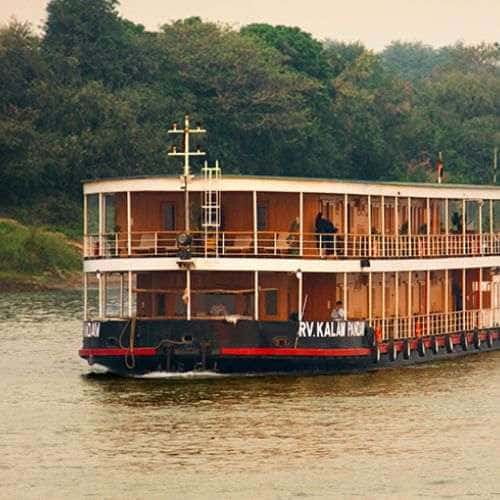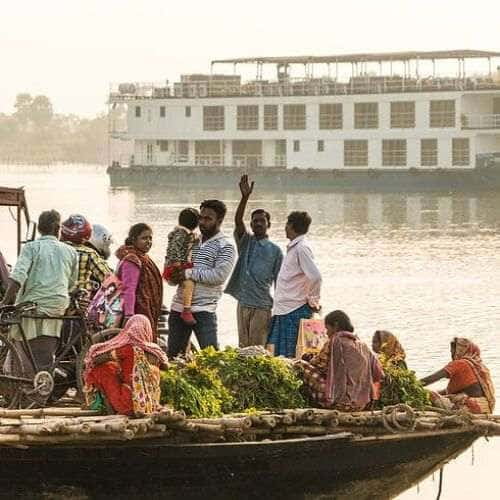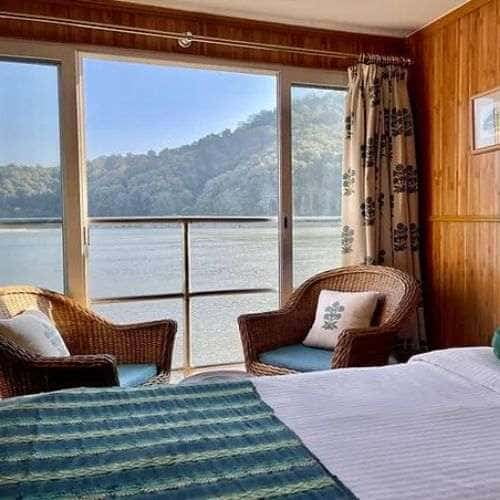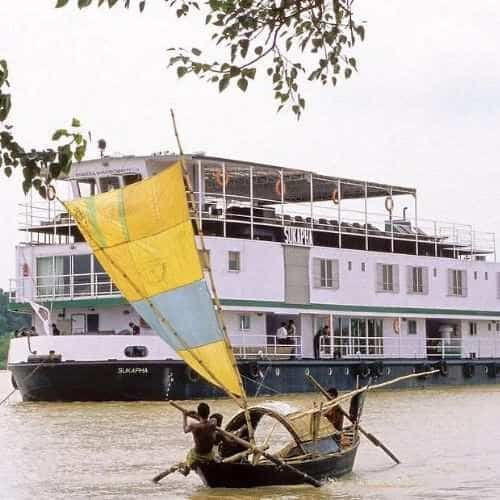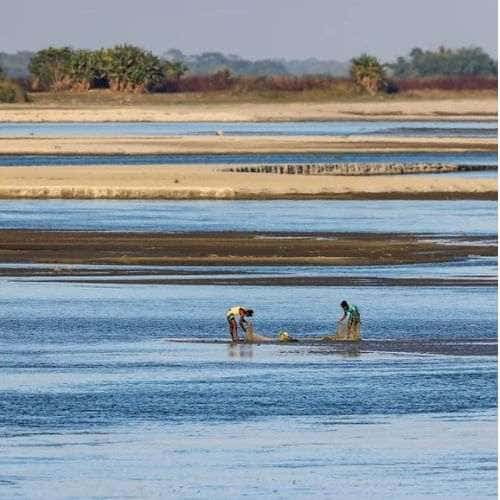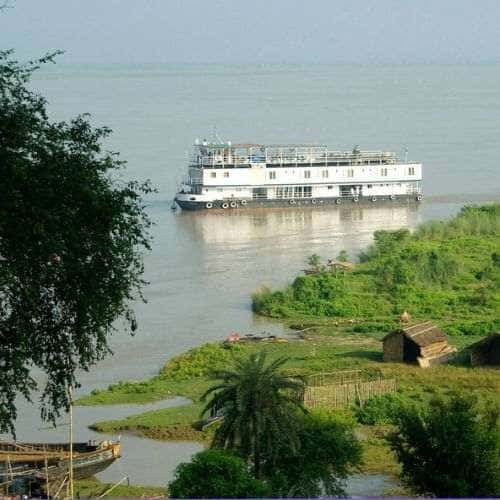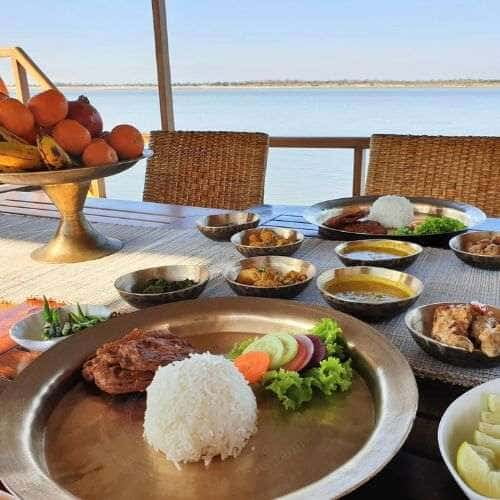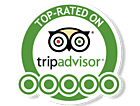Discover life around the mighty Brahmaputra on a luxury river cruise of India
The banks of the mighty Brahmaputra boast riches galore, from wildlife to tea gardens, walks through tiny villages to cycle rickshaw rides through country towns. With many places almost inaccessible on foot, a cruise is a leisurely, pleasurable way to experience the ‘real India’ in this often overlooked corner of the country.
Itinerary
Guwahati to Silghat
Day 01
Meet at Guwahati airport and transfer to our cruise at Pandu port. Enjoy lunch while cruising downstream to Sualkuchi. An afternoon walk through Sualkuchi, a bustling little town that is the centre of Assamese silk production, offers a chance to visit weaving workshops. Witness the whole process of silk manufacture, from cocoon and spinning, then dyeing to hand-weaving into exquisite mekhela chadars (a two-piece sari, the traditional attire of an Assamese woman). We then sail up to dock close to the great Saraighat bridge.
Day 02
This morning you’ll drive up Nilachal Hill to see the holy Kamakhya temple. With its tantric rites and animal sacrifice, the more squeamish may prefer to content themselves with the exteriors. Visit the poignant Commonwealth War Graves cemetery before embarking on your cruise vessel at Uzan Bazaar. We set sail and cruise past Kurua on the north bank.
Day 03
Morning cruise and visit to a riverside village with its lush green fields of vegetables. The day is spent mostly cruising upstream and presents an opportunity to catch up on reading, writing about your experiences so far, or simply watching life unfold on the riverbanks and jungle-covered hills that rise on either side. Enjoy an Indian cooking demonstration onboard.
Day 04
This morning you cruise on to reach Tezpur where, after lunch, you’ll visit the 6th century Da Parbatia temple ruins with its beautifully carved portal. Later, explore the town by cycle rickshaw, stopping at Cole Park with its mediaeval stone carvings saved from sites all over the region. Enjoy free time in the local market. The ship will be waiting at the town’s waterfront for you to reboard.
Day 05
After an early breakfast, drive for around two hours to the Nameri National Park at the foot of the blue hills of Arunachal Pradesh, the old North East Frontier Agency. Here, you take a float trip of around two hours down the Jia-Bhoreli River through the park. There are excellent bird-watching opportunities here (look out for the great Hornbills) and, perhaps, the chance of sighting wild elephants. After lunch, take a village walk before returning to the ship. Continue upstream, passing below a seemingly endless new bridge across the vast width of the riverbed, to moor at Silghat.
Day 06
Today, you drive to Kaziranga’s Central Range for a morning jeep safari. Enjoy lunch at Diphlu River Lodge before taking another jeep safari in the little visited Burapahar Range before returning to the boat. Covering an area of approximately 430 sq kms, the UNESCO World Heritage Site of Kaziranga National Park is home to the world’s largest population of the Indian One-Horned Rhinoceros as well as the Indian Wild Water Buffalo. It has also earned the distinction of having the highest density of Royal Bengal Tigers (one every five sq. km.), making this park an incredibly rich biodiversity hotspot. With its marshy swamps and thickets of elephant grass, the park supports large populations of Indian elephants, Indian bison, swamp deer, and Capped Langurs. Kaziranga National Park frequently draws comparisons to the Serengeti in Africa due to the park's abundance of wildlife and birds and is considered a birding paradise. Bird species found here include the Oriental Honey Buzzard, Black-shouldered Kite, White-tailed Eagle, Himalayan Griffon and many more.
Day 07
This morning, go on a visit to a local tea garden and the weekly market of Uloni. In the afternoon, drive to Kaziranga’s Western range (Bagori Range) for a jeep safari through the lush, biodiverse landscapes of the park.
Day 08
This morning you bid farewell to the crew and new friends as you set off for the 4-hour drive to Guwahati airport. Alternatively, we can arrange a 40-minute transfer to Tezpur airport or a 2 ½ hr transfer to Jorhat airport.
Guwahati to Silghat
Day 01
Meet at Guwahati airport and transfer to our cruise at Pandu port. Enjoy lunch while cruising downstream to Sualkuchi. An afternoon walk through Sualkuchi, a bustling little town that is the centre of Assamese silk production, offers a chance to visit weaving workshops. Witness the whole process of silk manufacture, from cocoon and spinning, then dyeing to hand-weaving into exquisite mekhela chadars (a two-piece sari, the traditional attire of an Assamese woman). We then sail up to dock close to the great Saraighat bridge.
Day 02
This morning you’ll drive up Nilachal Hill to see the holy Kamakhya temple, one of the most revered centres of tantric practices in India. Dedicated to the goddess Kamakhya (the goddess of desire, granter of desires), the temple symbolises the fusion of faiths and practices of Aryan and non-Aryan elements in Assam. We shall walk around the exteriors of the temple, among numerous pilgrims from around the country, taking in the sights, sounds and vibrant energy of the temple before returning to the vessel. Later, cruise up towards Mayong.
Day 03
This morning, cruise upstream and visit a riverside village with its lush green fields of vegetables. The day is spent mostly cruising upstream and presents an opportunity to catch up on reading, writing about your experiences so far, or simply watching life unfold on the riverbanks and jungle-covered hills that rise on either side. Enjoy an Indian cooking demonstration onboard.
Day 04
This morning you cruise on to reach Silghat where, after lunch, you’ll drive to Kaziranga National Park for a jeep safari in the Western range of the park. Covering an area of approximately 430 sq kms, the UNESCO World Heritage Site of Kaziranga National Park is home to the world’s largest population of the Indian One-Horned Rhinoceros as well as the Indian Wild Water Buffalo. It has also earned the distinction of having the highest density of Royal Bengal Tigers (one every five sq. km.), making this park an incredibly rich biodiversity hotspot. With its marshy swamps and thickets of elephant grass, the park supports large populations of Indian elephants, Indian bison, swamp deer, and Capped Langurs. Kaziranga National Park frequently draws comparisons to the Serengeti in Africa due to the park's abundance of wildlife and birds and is considered a birding paradise. Bird species found here include the Oriental Honey Buzzard, Black-shouldered Kite, White-tailed Eagle, Himalayan Griffon and many more.
Day 05
This morning, bid farewell to the crew and new friends as you set off for the 4-hour drive to Guwahati airport. Alternatively, we can arrange a 40-minute transfer to Kaziranga or a 2 ½ hr transfer to Jorhat airport.
Silghat to Dibrugarh/Jorhat
Day 01
Arrive at Jorhat airport and drive 2 ½ hrs to Silghat, a picturesque beach below jungle-covered hills and close to Kaziranga National Park. Alternatively, arrive at Guwahati airport and drive 4 ½ hrs to Silghat.
Day 02
After an early breakfast, you’ll be driven to Kaziranga’s Central Range for a morning jeep safari. Covering an area of approximately 430 sq kms, the UNESCO World Heritage Site of Kaziranga National Park is home to the world’s largest population of the Indian One-Horned Rhinoceros as well as the Indian Wild Water Buffalo. It has also earned the distinction of having the highest density of Royal Bengal Tigers (one every five sq. km.), making this park an incredibly rich biodiversity hotspot. With its marshy swamps and thickets of elephant grass, the park supports large populations of Indian elephants, Indian bison, swamp deer, and Capped Langurs. Kaziranga National Park frequently draws comparisons to the Serengeti in Africa due to the park's abundance of wildlife and birds and is considered a birding paradise. Bird species found here include the Oriental Honey Buzzard, Black-shouldered Kite, White-tailed Eagle, Himalayan Griffon and many more. Returning to the ship, you’ll cruise upstream with Kaziranga National Park on the right bank to anchor for the night at Vishnath.
Day 03
This morning you’ll visit Vishnath, known for its Ahom-period Shiva temple. Walk through the town before reboarding and setting off again, with Kaziranga still on the far bank. Keep an eye out for wild elephants which have been spotted, and once, memorably, a tiger. A leisurely afternoon of cruising down the river offers a good chance of spotting the endangered Gangetic dolphin, as well as observing life in the bankside villages as we pass. Arrive in the evening at Dhansiri Mukh.
Day 04
This morning, you’ll dock and take a jeep safari to Kaziranga’s little-visited Eastern Range, with grasslands much favoured by rhinos where you might also spot the rare Bengal Florican. Return to the boat and continue your cruise upstream.
Day 05
Today brings another opportunity to watch life unfold on the riverbanks as you cruise upstream. The languid pace of life onboard the boat offers a rare opportunity to sit and watch the world slip by, chat with fellow guests, or catch up on your reading. You’ll have time to stretch your legs with a walk through a bankside village, gaining an insight into life in rural India.
Day 06
You should reach Majuli Island around breakfast time. One of the world’s largest river islands and a microcosm of Assamese culture, Majuli is much-photographed but little-visited. It is a stronghold of the peaceful religion of neo-Vaishnavism and the elegant island satras — some for celibate monks, some for families — showcase a unique way of life where the faithful live simply, offering worship through gayan-bayan (songs and musical instruments) and readings. You’ll visit a monastery at Auniati with its eclectic museum, then attend a dance performance at Kamalabari monastery before cruising across to Neamati Ghat on the opposite bank. In the afternoon, you’ll have the opportunity to visit a nearby village.
Day 07
Today you’ll visit a tea estate in Jorhat, and observe the journey from tea bush to cup. (Please note that the factory is inoperative between December and mid-March.) Later, you’ll be driven to Sibsagar, the one-time capital of the Ahom kings of Assam. Shan by origin but converts to Hinduism, the Ahoms ruled Assam for some 700 years until the 1820s. Their culture and architecture is a unique and intriguing amalgam of India and Southeast Asia. You’ll see temples with stupa-like profiles and palaces of distinctive form. The temple tank here is believed to be the world’s largest hand-excavated reservoir and quite the feat of engineering, as you’ll see. Return to your ship, which will have cruised up to Neamati Ghat, close to Jorhat.
Day 08
This morning, you’ll be driven to Dibrugarh airport, a journey of around 4 ½ hours, passing through this typical colonial town and a major base for American flights over 'The Hump' to China in WWII. Alternatively, there’s the option of a 1 ½ hour drive to Jorhat airport.
Dibrugarh/Jorhat to Guwahati
Day 01
Arrive at Dibrugarh, a typical colonial town and major American base in WWII, then be driven for 4 ½ hrs to embark your ship at Neamati Ghat. Alternatively, arrive at Jorhat airport for a 1 ½ hrs drive to the embarkation point of Neamati Ghat.
Day 02
Your first excursion and experience of the rich variety of life along the Brahmaputra is Sibsagar, the one-time capital of the Ahom kings of Assam. Shan by origin but converts to Hinduism, the Ahoms ruled Assam for some 700 years until the 1820s. Their culture and architecture is a unique and intriguing amalgam of India and Southeast Asia. You’ll see temples with stupa-like profiles and palaces of distinctive form. The temple tank here is believed to be the world’s largest hand-excavated reservoir and quite the feat of engineering, as you’ll see. Lunch is taken at Horu Charai, a quintessential Assamese tea estate. Return to the ship and cruise downstream for three hours to Majuli island, one of the world’s largest river islands.
Day 03
A microcosm of Assamese culture, Majuli is much-photographed but little-visited. It is a stronghold of the peaceful religion of neo-Vaishnavism and the elegant island satras — some for celibate monks, some for families — showcase a unique way of life where the faithful live simply, offering worship through gayan-bayan (songs and musical instruments) and readings. You’ll visit a monastery at Auniati with its eclectic museum, then attend a dance performance at Kamalabari monastery. Later, return to the ship and cruise downstream for one or two hours.
Day 04
A day spent mostly sailing languidly along the Brahmaputra, though you’ll stop for a short visit to a tribal river village. By afternoon, Kaziranga National Park will be on your left – wild elephants are sometimes visible from the boat and once, memorably, a tiger, so keep an eye out for movement on the banks.
Day 05
This morning, you’ll arrive at the delightful temple town of Vishnath, known for its fine Ahom-period temple. Take a walk ashore to explore the architecture and village life before continuing the voyage down to a quaint mooring at Silghat, where butterflies abound in the surrounding jungle. Go on your first safari in Kaziranga National Park, a jeep ride through the woodlands, grasslands and wetlands of the Western Range.
Day 06
Today, you’ll be driven to Kaziranga’s Central Range for a morning jeep safari. Covering an area of approximately 430 sq kms, the UNESCO World Heritage Site of Kaziranga National Park is home to the world’s largest population of the Indian One-Horned Rhinoceros as well as the Indian Wild Water Buffalo. It has also earned the distinction of having the highest density of Royal Bengal Tigers (one every five sq. km.) making this park an incredibly rich biodiversity hotspot. With its marshy swamps and thickets of elephant grass, this park supports large populations of Indian elephants, Indian bison, swamp deer, and Capped Langurs. Kaziranga National Park frequently draws comparisons to the Serengeti in Africa due to the park's abundance of wildlife and birds and is considered a birding paradise. Bird species found here include the Oriental Honey Buzzard, Black-shouldered Kite, White-tailed Eagle, Himalayan Griffon and many more. In the afternoon, you’ll explore more of the Kaziranga National Park on another jeep safari.
Day 07
Cruise downstream under the seemingly endless new bridge to dock at Tezpur. After lunch on board, you’ll visit the remains of the 6th century Da Parbatia temple with its exquisitely carved portal. Cycle rickshaws transport you through the bustling bazaars to Cole Park with its collection of mediaeval stone carvings. Later, you’ll reboard the ship and cruise downstream to moor for the night near the isolated Singri Hill.
Day 08
The day is spent on the river, traversing a magical lunar landscape of sand islands before closing in on the range of hills beyond which lies Guwahati. Moor for the night not far from Ganesh Pahar.
Day 09
This morning’s voyage is particularly picturesque, sailing by jungle-covered hills on the south bank. Reaching Guwahati by midday, you’ll moor opposite the city and climb up to the pretty Aswaklanta temple before driving out to the temple ruins of Madan Kamdev, their erotic carvings an indicator of the strong tantric traditions of the area. Return to the ship and cruise downstream to Sualkuchi either this evening or the following morning.
Day 10
Take a walk through Sualkuchi, a bustling little town and the centre of Assamese silk production. Your visit to the weaving workshops is a rare opportunity to witness the whole process of silk manufacture, from cocoon and spinning to dyeing and hand-weaving into exquisite mekhela chadars (a two-piece sari, the traditional attire of an Assamese woman). You then sail up to dock close to the great Saraighat bridge and take a tour of Guwahati, driving up Nilachal Hill to the Kamakhya temple. With its tantric rites and animal sacrifices, the more squeamish may prefer to content themselves with its exteriors. Visit the poignant Commonwealth War Graves, the museum and the colourful bazaars.
Day 11
The day is spent on the river, traversing a magical lunar landscape of sand islands before closing in on the range of hills beyond which lies Guwahati. Moor for the night not far from Ganesh Pahar.
Guwahati to Guwahati
Day 01
Meet at Guwahati airport and embark your ship by mid-afternoon close to the great Saraighat Bridge. Enjoy lunch while cruising downstream to the little town of Sualkuchi, where the clatter of looms gives a clue to the town’s industry. Post-lunch, walk through the village and visit its silk-weaving workshops and observe the whole process of silk manufacture, from cocoon and spinning to dyeing and hand-weaving into exquisite mekhela chadars (a two-piece sari, the traditional attire of Assamese women).
Day 02
This morning you’ll cruise upstream and disembark at Pandu docks for a short sightseeing tour of the city of Guwahati. A drive up Nilachal Hill brings you to the holy Kamakhya temple, though with its tantric rites and animal sacrifice, the more squeamish among may prefer to content themselves with its exteriors. Visit the poignant Commonwealth War Graves cemetery as well as a shop selling local crafts. You’ll then cross by country boat to the mid-stream Peacock Island with its population of Golden Langurs before reboarding and cruising past Kurua on the north bank.
Day 03
Today you’ll cruise upstream past jungle-covered hills and turn into the Mayong River. Here you’ll take a country boat for a kilometre or two to the roadhead from where you’ll be driven to Pobitora Wildlife Sanctuary. This small park has a dense population of the Indian One-Horned Rhinoceros and it would be unlucky to not spot some of these armoured beasts on a jeep safari around the park. Those departing today are picked up from the park and driven for 4 ½ hrs to Kaziranga National Park. Return to the ship in the afternoon and cruise to a riverside village, which you can explore on foot. Later, sail downstream to spend the last night close to Kurua.
Day 04
Cruise down to Pandu port. Disembark after breakfast and transfer to Guwahati airport for your departure.
Quick Enquiry
from On Request
*excluding International flights
ABN Cruises operates on set dates and our Specialists would work with you as per your preferred travel dates
Why 'Private' Travel?

Full flexibility & personalized service with your own experienced private guide
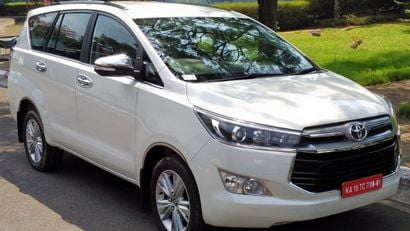
A private car & driver at your disposal for your holiday. Set your own pace
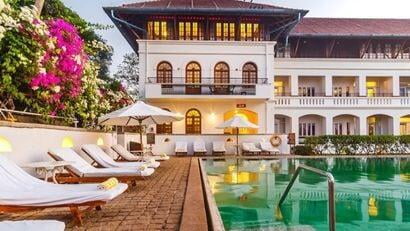
Select from hand-picked hotels; from luxury palaces to boutique homestays

Meet the locals & discover the real 'authentic' experiences of a destination
Our Reviews
Our guests seem happy to tell us about their experience and we are happy to share their thoughts with you.

Dear Pankaj, you delivered what we missed in our last 6 trips to India, a true Indian experience!! An advise for all those hesitating working with you, 'If you are tired of cookie-cutter tours and looking for an authentic travel experience in India, you are at the right place'.
Ms Elaine & Mr Wayne Helson, UK
I wanted to take the time to thank you for all the hard work you put in to arrange a magical honeymoon for us. We had a ball. All the transfers worked like clockwork, the hotels were great and the route planning excellent. We really felt we were spoon-fed all the way through.
You guys were absolutely true to your word, the holiday experience we have been waiting for years. Big thanks for arranging our visit to Ruskin Bond's home, you are certainly more than a holiday provider.
Mr Neil & Mrs Susan Everington, UK
Need more Ideas?
Experience a completely customized and flexible trip of a lifetime with India experts you can trust. We are an award-winning team that offers round-the-clock local support during your trip and 100% financial protection so you know you are in safe hands.
Let's create an exclusive journey for you!

